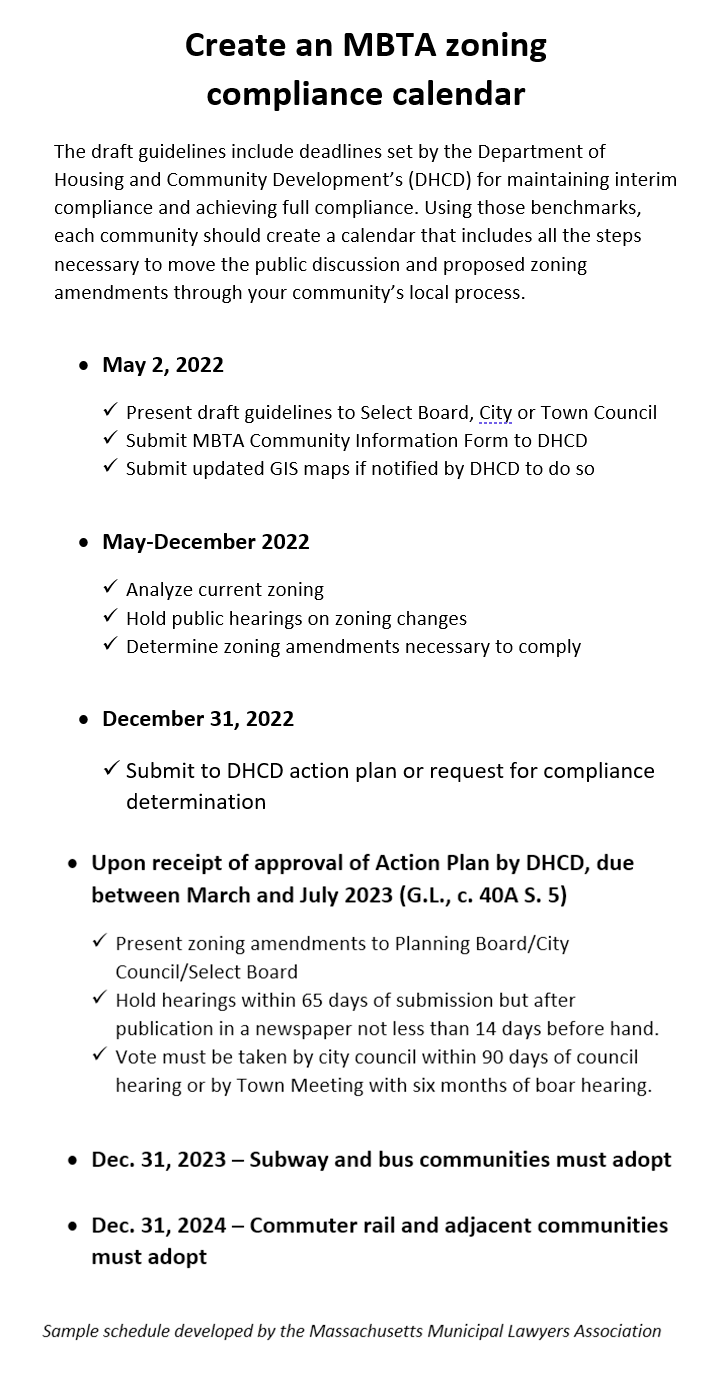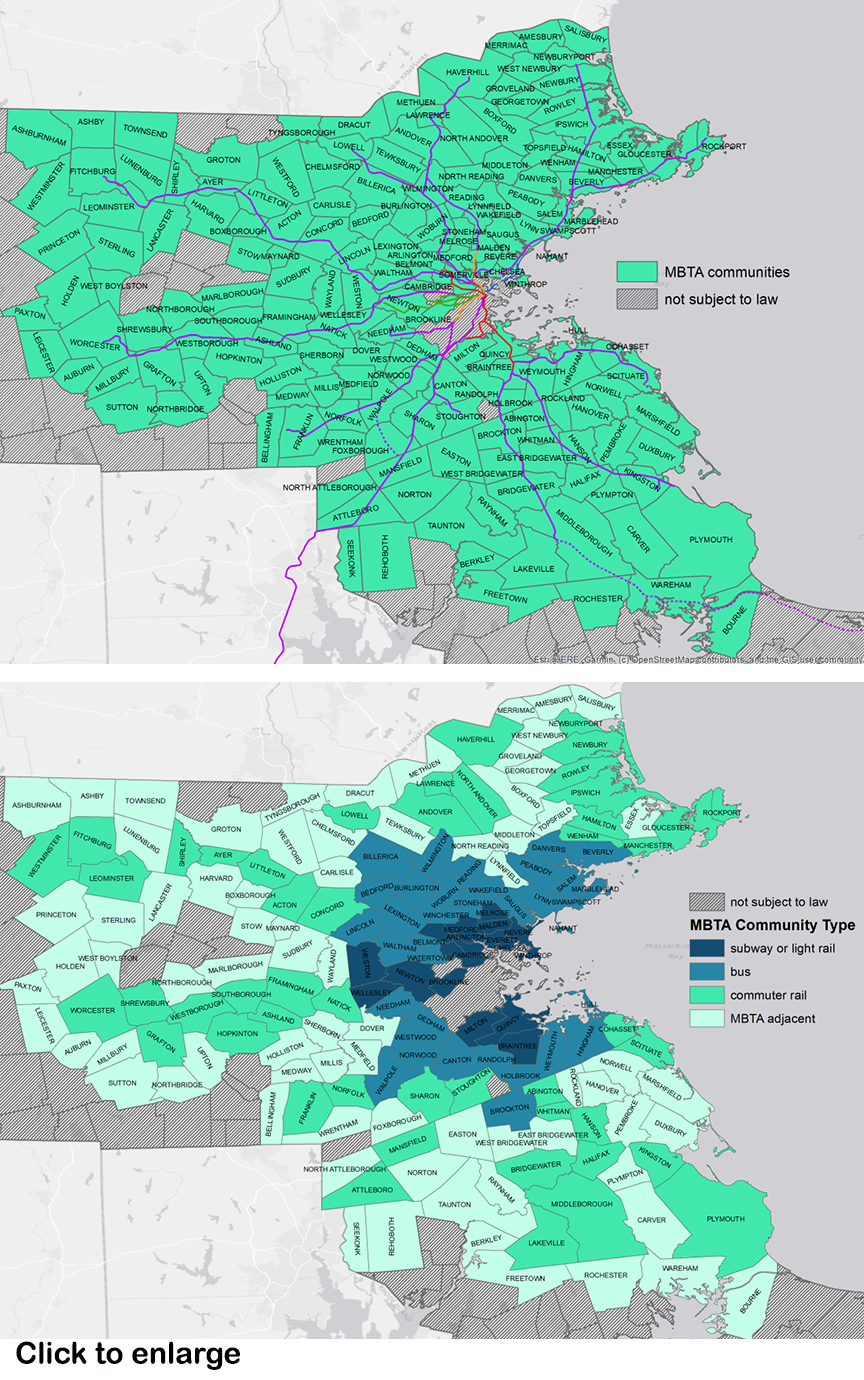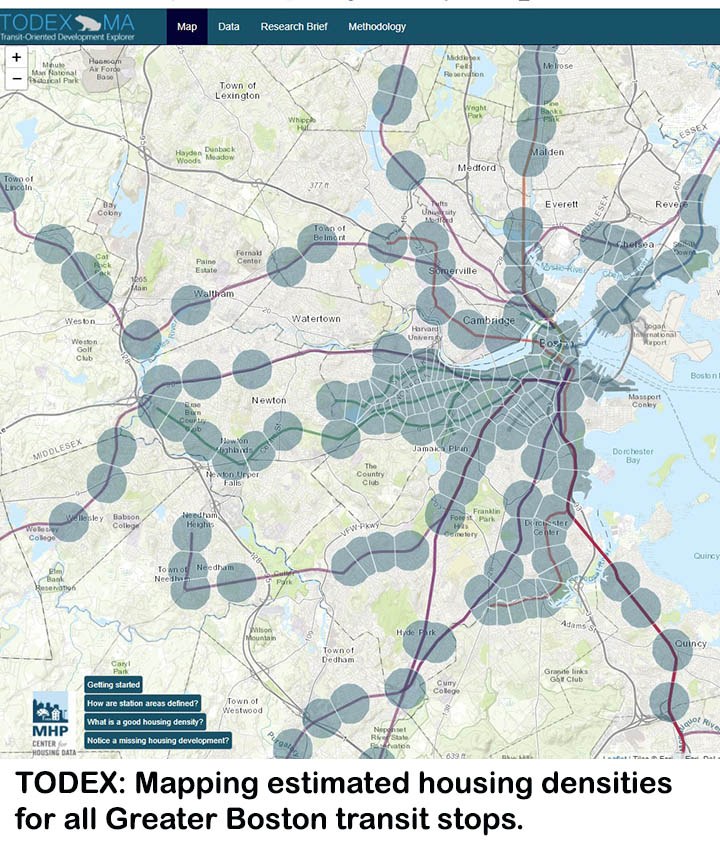Posted on March 9, 2022

By Katy Lacy
For planning staff and local officials in MBTA cities and towns, the challenge of adopting a multi-family zoning district may seem overwhelming, given that the guidelines are in draft form and could change between now and when they are finalized later in 2022.
In its role supporting state efforts to help communities comply, MHP has compiled eight things you can do now to get started:
Develop understanding of law, draft guidelines
The requirement that MBTA communities adopt a zoning district where multi-family housing is permitted as of right was enacted as part of the economic development bill in January 2021. The new Section 3A of M.G.L. c. 40A (the Zoning Act) reads, in its entirety
- (a)(1) An MBTA community shall have a zoning ordinance or by-law that provides for at least 1 district of reasonable size in which multi-family housing is permitted as of right; provided, however, that such multi-family housing shall be without age restrictions and shall be suitable for families with children. For the purposes of this section, a district of reasonable size shall: (i) have a minimum gross density of 15 units per acre, subject to any further limitations imposed by section 40 of chapter 131 and title 5 of the state environmental code established pursuant to section 13 of chapter 21A; and (ii) be located not more than 0.5 miles from a commuter rail station, subway station, ferry terminal or bus station, if applicable.
- (b) An MBTA community that fails to comply with this section shall not be eligible for funds from: (i) the Housing Choice Initiative as described by the governor in a message to the general court dated December 11, 2017; (ii) the Local Capital Projects Fund established in section 2EEEE of chapter 29; or (iii) the MassWorks infrastructure program established in section 63 of chapter 23A.
- (c) The department, in consultation with the Massachusetts Bay Transportation Authority and the Massachusetts Department of Transportation, shall promulgate guidelines to determine if an MBTA community is in compliance with this section.
The draft guidelines provide more information on what the law means and how communities can comply. At this point the guidelines for multi-family districts under Section 3A of the Zoning Act are in draft form, with a deadline for public comment March 31, 2022. The draft guidelines and more information can be found at Mass.gov Info for MBTA Communities. Especially useful is the MBTA Zoning FAQ , which is regularly updated as new questions are submitted.
The Department of Housing and Community Development (DHCD), the Executive Office of Housing and Economic Development (EOHED) and Regional Planning Agencies (RPAs) will be providing a variety of informational trainings to explain what is being required for each city and town. Other organizations have developed materials that explain the draft guidelines, but it is important to always refer back to Mass.gov's MBTA Communities website for the most up-to-date information on deadlines and submittal requirements.
Compliance step: Prepare a community presentation

One of the short-term requirements to stay in compliance while the draft guidelines are being finalized is for “a presentation of the draft guidelines in a meeting of the Select Board, City Council or Town Council, as applicable” to occur no later than May 2, 2022. The goal is to let local leadership know about the legislation and understand the implications of compliance vs. non-compliance. A few things to keep in mind:
- Develop a script. As a planner, local official, or housing advocate, it’s important to be comfortable explaining the new requirement in public meetings and to community members, housing advocates, developers and the press. If you don’t understand the guidelines or need more information, consult Mass.gov's detailed FAQ.
- Ideally, the public presentation should occur before the March 31 public comment deadline. Try to keep these sessions focused on explaining the new law and getting public comments on the draft guidelines.
- Emphasize that the draft guidelines won't be final until late spring/early summer of 2022. The only requirement for this presentation is to walk through the draft guidelines, making sure to emphasize applicable deadlines. While a few communities may have already identified possible compliance alternatives, most have not.
- Presentations should be recorded and put on the city or town website so it is available to the widest possible audience.
- Resources to help you organize your presentation are available on Mass.gov and MHP's MBTA Zoning and Complete Neighborhoods web page. MHP's resources include several presentations made by MBTA communities.
Identify existing tools, resources
Master Plans, Housing Production Plan, Subdivision Regulations, Zoning Ordinance or By-Law and the most recent zoning map could all inform the planning process. Some communities may have already done planning around their station area or are in the process of doing so.
Municipal resources including zoning maps, assessor’s records and maps, and open space plans are important. Planning, building and public works departments often have building, site and utility plans developed in association with building permit and infrastructure improvements plans.
Mapping tools will be very helpful at this early stage for thinking about and developing approaches to compliance. On-line tools that can be used for big-picture visioning include MassMapper, Google Maps and Zillow.
MassGIS is also a great resource, and provides assessor-level parcel information for every municipality in the Commonwealth. This page has more info on how to access this database, including the year that each community submitted their assessors data.
Plan community engagement outreach strategy
At the end of this process, a simple majority of your town meeting or city council will be required to approve to proposed new multi-family district. While providing your chief elected officials the information that they need to support the zoning change, they will also be looking for support from other city or town boards and committees, and the community as a whole.
Make a list of what local officials, boards and committees need to buy into the proposed zoning. Chapter 40A is clear that the adoption or amendment of a by-law or ordinance requires a formal recommendation from the local planning board. Many communities also require that their finance committee or advisory commission review proposed by-law changes. Input from the local building commission, conservation, school board, housing trust, police and/or fire departments can also make or break a zoning amendment. Community groups and neighborhood associations will also need to be brought on board.
Tips:
- Public meetings are good but try to make sure these meeting are recorded and posted on your municipal web site, along with all informational material.
- Get familiar with the community’s customary process for amending zoning. Chapter 40A spells out the “official” role of planning boards, city councils and town meetings in the zoning amendment process. In many communities, additional committees and officials (finance, city manager, town moderator) are asked to weigh in on proposed zoning changes, and may expect their own special presentation or one-on-one meeting. Required or not, loop in as many boards and committees as possible.
- Identify contacts outside of municipal government to help get the word out. Reach out to neighborhood associations, the library, senior center and community groups like the Rotary, League of Women Voters, Chamber of Commerce to see if they would host an informational event.
- Make sure that your local paper, cable TV station and radio station have the information to inform the community. Prepare an informal press briefing with the basic information about the proposed zoning change, making sure to clearly identify times, dates and details of upcoming hearings and/or votes.
- Identify community influencers. Every community has people that others look to for guidance on local matters. Who are those people, and how can they brought up to speed?
Review existing zoning & regulatory framework
Take a look at the basic districts provided for in your zoning, the uses allowed in each district, and the intensity requirements (height, setbacks, etc.) that apply to each district. What uses require a special permit, and which ones are “by-right?” Do the requirements reflect actual existing conditions in the district? Many of our communities have older downtown areas where the existing buildings like three-story Victorian homes on smaller lots are non-conforming. What would it take to bring those lots into conformity?
Is there a district where multi-family or mixed-use development is already permitted by-right or with one or more special permit? If so, review these provisions for common obstacles including large lot sizes (oft stated as per unit lot size), height limits lower than three stories, excessive parking requirements and local and septic provisions that exceed Title V. Permit or approval requirements from multiple boards and committees --- planning, zoning, design review, historic district commissions, conservation commissions, boards of health --- can create additional hurdles.
If your zoning includes overlay districts, map out the use and intensity limitations in those districts. Some overlay districts allow for additional uses such as mixed residential and commercial structures as well as relaxed intensity requirements such as additional height and larger floor area ratios, typically with a special permit. Other overlay districts, such as a groundwater protection district or a floodplain district are not optional, and require mandatory additional restrictions or conditions on all development within those areas.
Consider the best regulatory approach for bringing your zoning into compliance with the MBTA communities multi-family zoning requirement. Questions to ask include:
- Is there a district that could comply with the basic requirements as currently outlined in the draft guidelines?
- Is there zoning that may comply with some of the provisions, but would require amending to comply? Many communities have zoning districts that allow multi-family by-right, but the district itself would need to be expanded, or permitted levels of intensity modified.
- If the community has a 40R District in place, identify what changes would be required to bring that into compliance.
Another option would be to create an entirely new district, similar to a 40R District, in which the new requirements apply only to that district, and over-ride all existing zoning. This approach has significant advantages in that it would avoid situations where underlying zoning provisions could conflict.
Review existing conditions, consider possible district locations

Review existing development patterns. Are there areas where higher density housing already exists? Particularly in communities with older, “historic” downtown areas, it may be that there are existing properties, block, or entire neighborhoods that already have densities of 15 units an acre or higher. Even if these areas will not ultimately be included in the proposed district, being able to provide examples of existing higher density can be useful. Alternatively, where are the areas where multi-family housing really doesn’t make sense, due to incompatible land uses, lack of infrastructure, or environmental constraints?
For communities with a transit station, document conditions in the surrounding area, including existing development, vacant parcels, state and municipal property, wetland and floodplain areas. MHP’s TODEX tool may be useful here as it allows users to measure the existing residential density within a half mile of every transit station in Greater Boston.
The draft guidelines require that outside of extenuating circumstances, at least 50 percent of the total district should be located within .5 miles of a station area boundary. The remaining area can be located in other areas, as long as those areas are at least five acres in size and “easily accessible to transit based on existing street patterns, pedestrian connections, and bicycle lands. Are there other areas in your community where higher density housing may already exist, or would be suitable? It may be a good idea to identify a few alternative scenarios for achieving compliance.
Identify your team, ask for help
Developing and adopting a new zoning district is a big deal, and no one staff person, municipal board or committee can do it alone. It’s helpful to identify someone at city or town hall who will be managing the process and what other staff, officials, boards and community groups should be involved in the planning and adoption of the new district. It's also good to know what role does municipal counsel typically play in your community's zoning amendment process.
Consider what groups or individuals would be the most effective champion. Municipal planning staff may find it challenging to move the community towards compliance in the face of elected officials and members of the public who oppose the multi-family zoning requirement. There may be someone else in municipal government who would be a more effective spokesperson.
Many cities and towns may need technical assistance from one or more outside consultants to identify the district boundaries, draft new zoning language, and prepare and submit required materials to DHCD for compliance. MHP will offer technical assistance grants to cities and towns to support the adoption of multi-family zoning starting in the Spring of 2022.
Other funding sources municipalities can look to for help include:
- FY23 Community One Stop for Growth: MBTA Communities can apply for assistance from the Housing Choice Grant Program, Community Planning Grants, and the Rural Development Fund. This application is open now, with Expressions of Interest due by March 18, 2022, and full applications due by June 3, 2022. For more information, go to ONE Stop for Growth.
- FY23 Executive Office of Energy and Environmental Affairs (EOEEA) Land Use Planning Grant Program will prioritize MBTA Communities. Grant Applications are typically due in late May. Email EOEEA's Kurt Gaertner for more information.
- FY23 District Local Technical Assistance (DLTA) Program: Contact your regional planning agency for more information.
Develop compliance timeline
Even though the guidelines are in draft form, it is not too early to start mapping out a timeline for adopting a new multifamily district. A basic overview of short term compliance deadlines currently proposed for all MBTA Communities can be found on the MHP website at MBTA Communities compliance deadlines. The Massachusetts Municipal Lawyers Association has also developed a sample compliance schedule.
Add in circumstances specific to your community. For example, the timelines for adopting or amending zoning is different for cities and towns, with cities having more flexibility in terms of timing around when a vote could take place. Boards required to weigh in on zoning proposals may meet monthly in some towns, and weekly in others. Some communities will need an outside consultant, others have in-house capacity. For those who do need a consultant, can this cost be covered by the municipality, or will you need to apply for a grant?
(Katy Lacy is a senior planner at MHP and formerly the community planning director for the Town of Hingham She can be reached at klacy@mhp.net).
